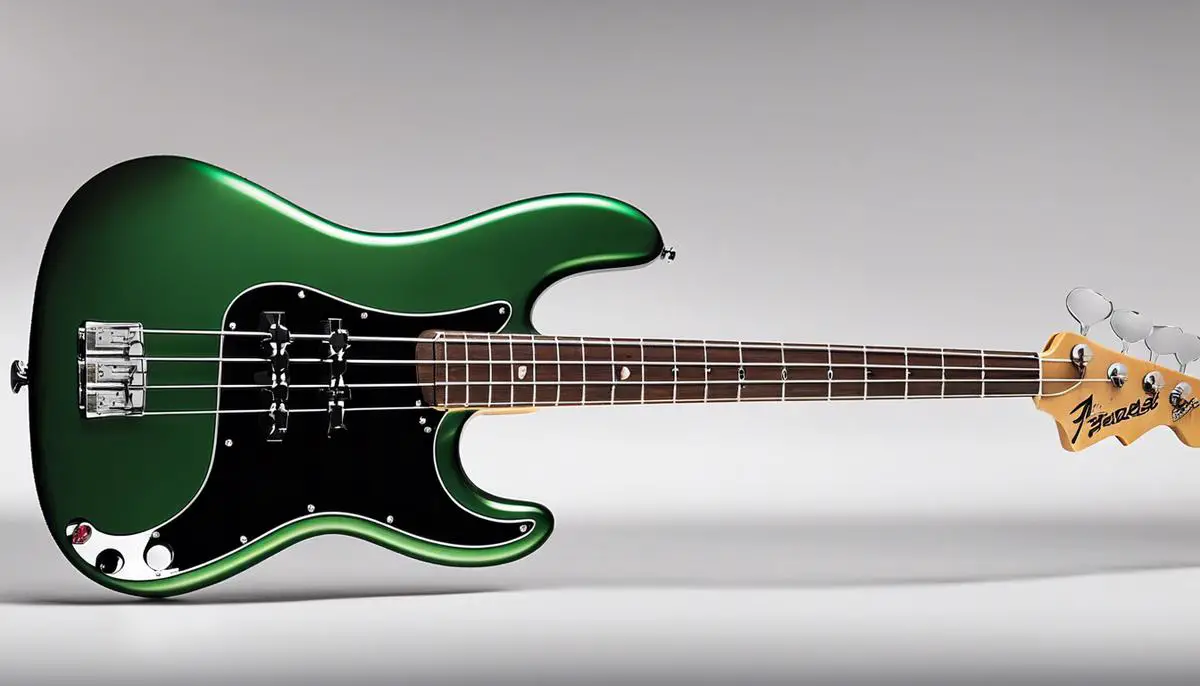P Bass Tone Settings. Renowned for their distinct, full-bodied tone and timeless design, Precision Basses, or P basses, have secured their place in the pantheon of iconic instruments. Their punchy, powerful tone has proven integral to different musical genres, from jazz to rock and everything in between.
Upon understanding a P Bass’s unique characteristics, manipulating its tone controls, and appreciating the role of strings and pickups, you’ll have mastery over the majestic universe of bass tones. This knowledge enables you to articulate your preferred sound and tailors an aural identity distinctive to your musical style.
Let’s delve into the fascinating journey of exploring P Bass, from its design features to the significant impact of strings and pickups on the overall tone.
Table of Contents
Understanding the P Bass
Exploring the Majesty of the P Bass Sound: A Unique Harmonic Beast
Strum into the heart of any music lover, and you will undoubtedly discover their passion, a pulse— a beat that thrives on the exploration and experimentation of sound. Within this realm exists an instrument resonating with power and presence: the P Bass. Commanding its position in the music industry, from rock’n’roll to jazz, this iconic instrument is the cornerstone of many musicians’ ensembles due to its remarkable tone and presence.
First introduced in 1951 by Leo Fender, the Precision Bass (affectionally known as the P Bass) was a daring leap into uncharted territories, pioneering the path for an electrified future in music. The P Bass triumphed with its simplistic design and robust sound, which enchanted many and swiftly ingrained it within the music industry.
The P Bass Sound
The power of the P Bass lies within its design. The signature split-coil pickup, a revolutionary design from Fender at the time, grants it a characteristic punch and warmth that bassists have revered. This design cancels out the hum typical of single-coil pickups while keeping the sound robust and complete. This split-coil hum-bucking system deeply impacted the tone, offering a full, thicker sound that stays clear, bright, and less muddy—even at higher volumes.
This distinctive sound does not merely transpose to a single genre; the P Bass thrives in various musical styles. From the rumbling low-ends needed to fuel the heart of rock’n’roll, the punch necessary for the syncopated rhythms of funk, or the melodic wistfulness that paints the vibrant tableau of jazz, the P Bass’ versatility of tone empowers musicians with an audio Swiss-army knife, prepared for any occasion.
What also sets the P Bass apart is its neck profile. From years of refinement, Fender has perfected a comfortable ‘C’ shaped neck with a thick, broad profile that leads to a rounder, fuller tone. This influence on tone may seem subtle and trivial, but these nuanced undertones embellish the musician’s musical vocabulary and cultivate a richly distinctive sound.
Looking at the fretboard, the wide string spacing compared to other bass guitars further contributes to the P Bass’ uniqueness. This spacing caters to fingerstyle bassists, allowing both subtle and striking techniques to be embraced, providing another avenue for a musician’s expression and diversification of tone.
Beneath the music lines and tabs, the soul and lineage of a P Bass sing profoundly in its warm, punchy tone. Its deep-rooted legacy, fused with distinctive characteristics, creates a unique expression for musicians to tap into. In the hands of a seasoned veteran or a budding enthusiast, a P Bass is not just an instrument—it’s a musical ally waiting to reveal the next chapter of sound. When those plucked strings reverberate, sending out a commanding signal, it’s an unmistakable voice—that of the iconic P Bass.

Manipulating the Tone Controls
P Bass Tone Knob
In diving deeper into the nuanced world of the P Bass sound, it becomes critical to discern how one can fine-tune this instrument to match a desired sound. This isn’t mere fiddling; this is the art of crafting sound waves, the science of bringing alive those notes that live within the heart of the musician. So, let’s explore how to adjust the tone controls of a P Bass in an optimum fashion.
Now, one cannot discuss the tone controls of a P Bass without first acknowledging the dual-volume control feature. Singular to the P Bass, each split-coil pickup can be manipulated independently, allowing a remarkable customization level. To accentuate the punchier low ends, dial up the neck pickup volume. Conversely, boosting the bridge pickup volume will highlight the crisp, bright melodies for which the P Bass is renowned. If only you knew how to navigate it, it would be a veritable soundscape at your fingertips.
But it doesn’t stop at volume; the P Bass tone knob is the unsung hero in this symphony of sounds. As solitary as it may seem, tone control is pivotal in the rich sound from a P Bass. It acts almost as an EQ, allowing you to adjust the audio filter, adding color and dimension to the raw, unedited sound. Want a warmer, vintage sound resonating from the core of your P Bass? Roll off the tone and let it transport you back to the golden bass era. It’s musical time travel for those with an enriched palette and a love for nostalgia.
However, this isn’t a one-note performance. There’s a point of balance, a sweet spot if you may, where the tone and volume controls work in tandem to compose the authentic P bass sound. This is where the musician’s personal touch plays a pivotal role. For an aggressive rock or funk sound, max out both volume controls and roll off the tone to taste. Jazz and R&B, on the other hand, necessitate a more mellow sound. Subduing one or both volume knobs and dishing out more tones will achieve this.
The beauty of a P Bass lies in its complexity masked underneath an illusion of simplicity. The different knobs, the dual-volume control, the wide string spacing – they’re all instruments directing the symphony of sounds that it can create. With every tweak, every tune, you’re not just crafting a sound; you’re constructing an emotion – your unique brand of music. Just as the chords of a song bring together a diverse group of music enthusiasts, the tone control on a P Bass brings together harmony and rhythm, forming the melodious output we understand as music. The magic, indeed, is in the mastery of these
tone controls, where you, the musician, become the conductor of your symphony.

The Role of Strings and Pickups
Embracing the Revelry in Resonance: A Deeper Dive into the Influence of String Types and Pickups on P Bass Tone
In the vast universe of music, where tones pulse like galaxies and sound waves ripple and weave like cosmic threads, the Precision Bass guitar, reverently known as the P Bass, reigns as one of music’s enigmatic constellations. The magic woven into the P Bass goes beyond its charming morphology – it’s tucked within the heart and soul of the musical entity: its strings and pickups. These facets wield the power to influence the P Bass tone, transforming a simple chord into a symphony of sound.
Strings, those slender oscillating marvels, don’t simply vibrate. They sing, cry, shout, whisper; they echo the nuanced crests and troughs of human emotion in their silent dance. Choosing the correct string for a P Bass isn’t merely a personal preference – each string type carries distinct tonal characteristics, influencing the guitar’s resonance and echoing its unique voice.
Roundwound, flatwound, and tape-wound bass strings offer unique tonal flavors for the P Bass sound. Roundwounds, the most popular variant, offers a bright, edgy sound ideal for genres like rock or blues. Meanwhile, jazz and R&B players might lean more towards flatwounds, which provide a smoother, mellow tone. Tapewounds, while less common, encapsulate the best of both worlds, offering a warm yet sharp sound.
The type of string alone, however, is not the sole conductor of melody. Metals, too, can alter the P Bass sound in incredibly intricate ways. Nickel strings “smile” at you with a warm, vintage tone, while stainless steel strings have an edgier, brighter sound. Mixed metal strings offer a balanced tone, ideal for those who desire a middle ground between warm and colorful tones.
No discussion about P Bass tone can be complete without dipping into the ocean of pickups. Those electromagnetic wonders inhale the string vibrations and exhale them as musical notes through your amplifier. The type of pickup selected can directly influence the P Bass tone, manifesting a specific aural ambiance.
There are two kinds of pickups: the single-coil pickup and the humbucker. Traditionally, P Bass guitars come equipped with the split-coil humbucker, a design that minimizes unwanted hum and injects a hearty low-end into the sound. However, some musicians have jazzed up their P Bass by swopping the split coil with single-coil pickups for a more vintage sound, echoing back to the sonic signatures of early rock ‘n’ roll.
Understanding the essential relationship between the string types and pickups is music’s equivalent to alchemy. It’s uncorking bottles of unique, deeply expressive tonal possibilities that exist within a P Bass’s design. One can coax an extraordinary chorus of vibrant voices from a single instrument by harnessing their power, thereby painting broader strokes on the canvas of human sentiment. Every twang, strum, pluck and shred morphs into notes that vibrate perfectly with the musician’s soul, bringing forth a new layer of the musical universe to explore.
String types and pickups don’t just shape P Bass tones – they guide the flow of emotions between the musician and the instrument. They are the hidden strings nimbly plucked by the silent puppeteer: the musician. Ultimately, the P Bass truly shines with its strings and pickups within this complexity and inclusivity of tonal expression. Dance with these nuances, and one can craft an intensity of sound that doesn’t just echo through an auditorium but through the soul of the music itself. This is the power of the P Bass and, indeed, the power of music.

Embarking on this exploration, we’ve demystified the components that come together to create the unique, beloved tone of a P Bass. From comprehending its overall design to manipulating the volume and tone controls, we have realized the power of these factors in forming a range of tones.
Further, acknowledging the impact of strings and pickups has provided us with new avenues to customize and personalize our sound.
Armed with this knowledge and a deeper appreciation for these instruments, we are better equipped to fully exploit a P Bass’s tonal possibilities fully, thereby enriching our musical expression and listeners’ aural experience.
Tone settings Table per Music Genre
P Bass Tone Settings
A precision bass sound’s ideal volume and tone settings vary depending on the music genre. However, as a starting point, you can set the Bass to around 4 and the treble to around 6 to achieve a well-rounded sound suitable for most music genres.
Bass Guitar Settings
Here is a table summarizing the ideal volume and tone settings for different music genres:
| Music Genre | Volume Control | Tone Control |
|---|---|---|
| Pop | 5-6 | 6-7 |
| Rock | 6-7 | 5-6 |
| Funk | 7-8 | 4-5 |
| Soul | 5-6 | 6-7 |
| Disco | 6-7 | 5-6 |
| R&B | 5-6 | 6-7 |
| Country and Western | 6-7 | 5-6 |
Source: 1talkbass.com 2prosoundhq.com
Please note that these settings are not exhaustive and are only meant to serve as a starting point. The beauty of a P Bass sound lies in its complexity and the different knobs that allow you to craft your unique brand of music. With every tweak, every tune, you’re not just crafting a sound; you’re constructing an emotion – your symphony.


